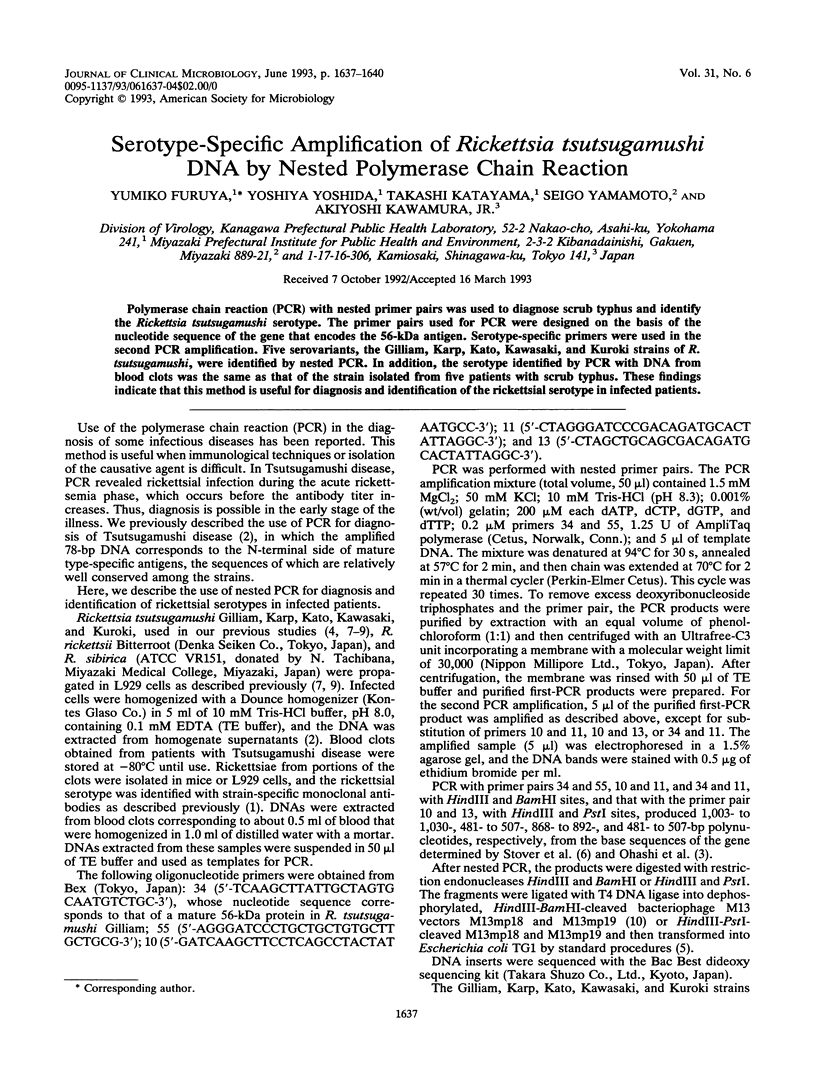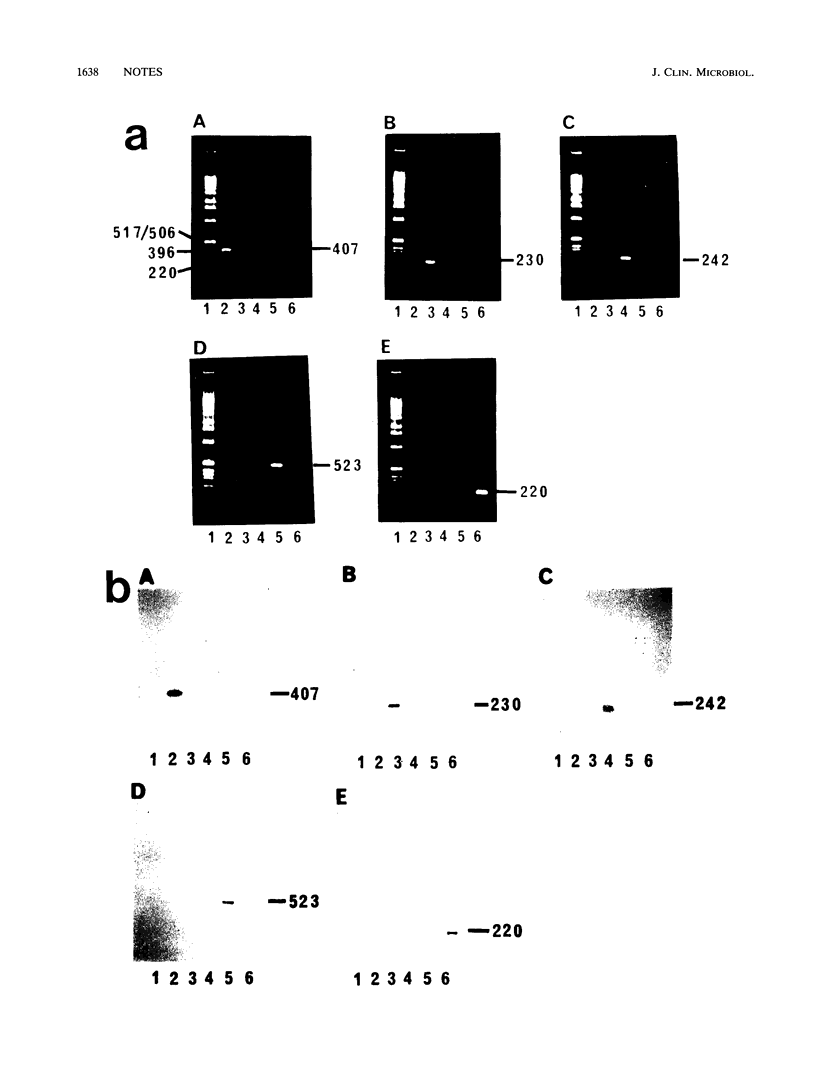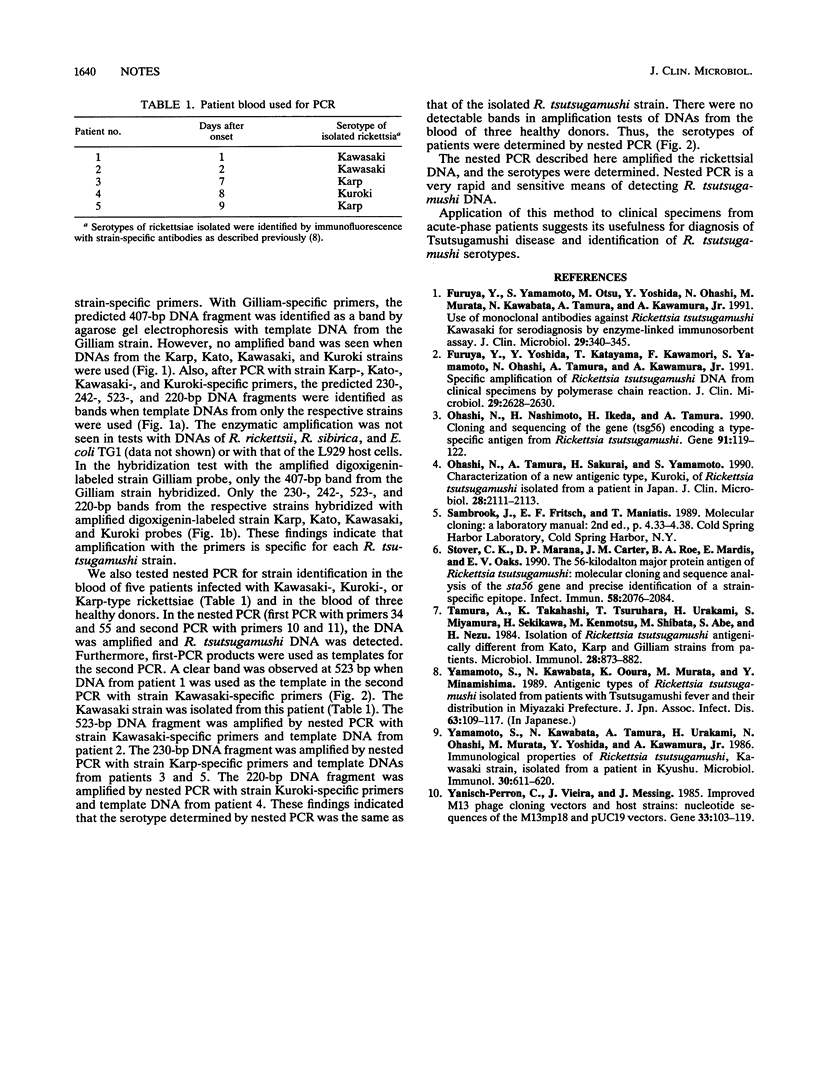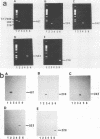Abstract
Polymerase chain reaction (PCR) with nested primer pairs was used to diagnose scrub typhus and identify the Rickettsia tsutsugamushi serotype. The primer pairs used for PCR were designed on the basis of the nucleotide sequence of the gene that encodes the 56-kDa antigen. Serotype-specific primers were used in the second PCR amplification. Five serovariants, the Gilliam, Karp, Kato, Kawasaki, and Kuroki strains of R. tsutsugamushi, were identified by nested PCR. In addition, the serotype identified by PCR with DNA from blood clots was the same as that of the strain isolated from five patients with scrub typhus. These findings indicate that this method is useful for diagnosis and identification of the rickettsial serotype in infected patients.
Full text
PDF



Images in this article
Selected References
These references are in PubMed. This may not be the complete list of references from this article.
- Furuya Y., Yamamoto S., Otu M., Yoshida Y., Ohashi N., Murata M., Kawabata N., Tamura A., Kawamura A., Jr Use of monoclonal antibodies against Rickettsia tsutsugamushi Kawasaki for serodiagnosis by enzyme-linked immunosorbent assay. J Clin Microbiol. 1991 Feb;29(2):340–345. doi: 10.1128/jcm.29.2.340-345.1991. [DOI] [PMC free article] [PubMed] [Google Scholar]
- Furuya Y., Yoshida Y., Katayama T., Kawamori F., Yamamoto S., Ohashi N., Tamura A., Kawamura A., Jr Specific amplification of Rickettsia tsutsugamushi DNA from clinical specimens by polymerase chain reaction. J Clin Microbiol. 1991 Nov;29(11):2628–2630. doi: 10.1128/jcm.29.11.2628-2630.1991. [DOI] [PMC free article] [PubMed] [Google Scholar]
- Ohashi N., Nashimoto H., Ikeda H., Tamura A. Cloning and sequencing of the gene (tsg56) encoding a type-specific antigen from Rickettsia tsutsugamushi. Gene. 1990 Jul 2;91(1):119–122. doi: 10.1016/0378-1119(90)90171-m. [DOI] [PubMed] [Google Scholar]
- Ohashi N., Tamura A., Sakurai H., Yamamoto S. Characterization of a new antigenic type, Kuroki, of Rickettsia tsutsugamushi isolated from a patient in Japan. J Clin Microbiol. 1990 Sep;28(9):2111–2113. doi: 10.1128/jcm.28.9.2111-2113.1990. [DOI] [PMC free article] [PubMed] [Google Scholar]
- Stover C. K., Marana D. P., Carter J. M., Roe B. A., Mardis E., Oaks E. V. The 56-kilodalton major protein antigen of Rickettsia tsutsugamushi: molecular cloning and sequence analysis of the sta56 gene and precise identification of a strain-specific epitope. Infect Immun. 1990 Jul;58(7):2076–2084. doi: 10.1128/iai.58.7.2076-2084.1990. [DOI] [PMC free article] [PubMed] [Google Scholar]
- Tamura A., Takahashi K., Tsuruhara T., Urakami H., Miyamura S., Sekikawa H., Kenmotsu M., Shibata M., Abe S., Nezu H. Isolation of Rickettsia tsutsugamushi antigenically different from Kato, Karp, and Gilliam strains from patients. Microbiol Immunol. 1984;28(8):873–882. doi: 10.1111/j.1348-0421.1984.tb00743.x. [DOI] [PubMed] [Google Scholar]
- Yamamoto S., Kawabata N., Ooura K., Murata M., Minamishima Y. [Antigenic types of Rickettsia tsutsugamushi isolated from patients with tsutsugamushi fever and their distribution in Miyazaki Prefecture]. Kansenshogaku Zasshi. 1989 Feb;63(2):109–117. doi: 10.11150/kansenshogakuzasshi1970.63.109. [DOI] [PubMed] [Google Scholar]
- Yamamoto S., Kawabata N., Tamura A., Urakami H., Ohashi N., Murata M., Yoshida Y., Kawamura A., Jr Immunological properties of Rickettsia tsutsugamushi, Kawasaki strain, isolated from a patient in Kyushu. Microbiol Immunol. 1986;30(7):611–620. doi: 10.1111/j.1348-0421.1986.tb02988.x. [DOI] [PubMed] [Google Scholar]
- Yanisch-Perron C., Vieira J., Messing J. Improved M13 phage cloning vectors and host strains: nucleotide sequences of the M13mp18 and pUC19 vectors. Gene. 1985;33(1):103–119. doi: 10.1016/0378-1119(85)90120-9. [DOI] [PubMed] [Google Scholar]




